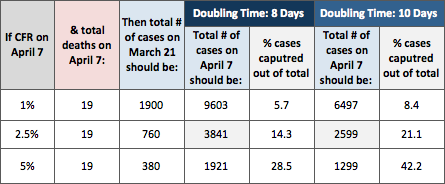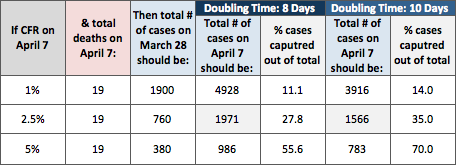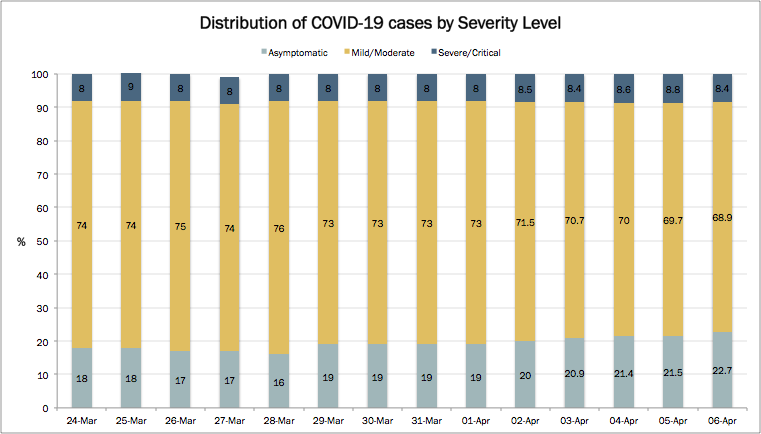@mophleb @DRM_Lebanon @WHOLebanon and for those -prematurely- celebrating the containment of COVID19 in Lebanon  https://abs.twimg.com/emoji/v2/... draggable="false" alt="🇱🇧" title="Flag of Lebanon" aria-label="Emoji: Flag of Lebanon">; check this out please
https://abs.twimg.com/emoji/v2/... draggable="false" alt="🇱🇧" title="Flag of Lebanon" aria-label="Emoji: Flag of Lebanon">; check this out please  https://abs.twimg.com/emoji/v2/... draggable="false" alt="👇" title="Down pointing backhand index" aria-label="Emoji: Down pointing backhand index">
https://abs.twimg.com/emoji/v2/... draggable="false" alt="👇" title="Down pointing backhand index" aria-label="Emoji: Down pointing backhand index">
#Lebanon #COVID19 #healthNERDS
@thehealthnerds
#Lebanon #COVID19 #healthNERDS
@thehealthnerds
1/ The only certain # we currently have is the total # of deaths. As shown in previous thread & based on an approach that is used in other countries, you can estimate the “potential” # of cases that we should have in order to have 19 deaths on April 7.
2/ How to do this?
Examine different case fatality ratios (CFRs): 1%, 2.5%, 5%
Examine different times to death: 17 days & 10 days
# of deaths on April 7 = 19
Calculate potential # of cases based on different growth rates (doubling time: 8 days, 10 days)
Examine different case fatality ratios (CFRs): 1%, 2.5%, 5%
Examine different times to death: 17 days & 10 days
# of deaths on April 7 = 19
Calculate potential # of cases based on different growth rates (doubling time: 8 days, 10 days)
3/ Time to death = 17 days
If we go with the likely (best case) scenario of 2.5% CFR & doubling time of 10 days (containment measures are working), we should have 2599 cases TODAY in order to have 19 deaths.
If we go with the likely (best case) scenario of 2.5% CFR & doubling time of 10 days (containment measures are working), we should have 2599 cases TODAY in order to have 19 deaths.
4/ Time to death = 10 days
If we go with likely (best case) scenario of 2.5% CFR & doubling time of 10 days (containment measures are working), we should have 1566 cases TODAY in order to have 19 deaths.
If we go with likely (best case) scenario of 2.5% CFR & doubling time of 10 days (containment measures are working), we should have 1566 cases TODAY in order to have 19 deaths.
5/ The total # of cases should be between 1566 & 2599 in order to have 19 deaths today (time to death between 10 and 17 days); i.e., we are missing cases by a factor of ~ 3 to 5.
6/ A question arises: If we are missing all these cases, why aren’t we seeing a surge in ICU admissions https://abs.twimg.com/emoji/v2/... draggable="false" alt="❓" title="Red question mark ornament" aria-label="Emoji: Red question mark ornament">
https://abs.twimg.com/emoji/v2/... draggable="false" alt="❓" title="Red question mark ornament" aria-label="Emoji: Red question mark ornament">
 https://abs.twimg.com/emoji/v2/... draggable="false" alt="👇" title="Down pointing backhand index" aria-label="Emoji: Down pointing backhand index">
https://abs.twimg.com/emoji/v2/... draggable="false" alt="👇" title="Down pointing backhand index" aria-label="Emoji: Down pointing backhand index">
7/ Out of 467 active cases, 88 are hospitalized & 11 are in ICU. So the majority of cases in Lebanon don’t require hospitalization.
If the cases we are missing are mild (don’t require hospitalization), then, they won’t get identified because they aren’t tested/hospitalized.
If the cases we are missing are mild (don’t require hospitalization), then, they won’t get identified because they aren’t tested/hospitalized.
8/ If the missing cases are mild/don’t require hospitalization, does it matter that we are missing them?
Short-term https://abs.twimg.com/emoji/v2/... draggable="false" alt="➡️" title="Rightwards arrow" aria-label="Emoji: Rightwards arrow"> No, if we only consider healthcare system capacity
https://abs.twimg.com/emoji/v2/... draggable="false" alt="➡️" title="Rightwards arrow" aria-label="Emoji: Rightwards arrow"> No, if we only consider healthcare system capacity
Long-term https://abs.twimg.com/emoji/v2/... draggable="false" alt="➡️" title="Rightwards arrow" aria-label="Emoji: Rightwards arrow"> Yes, if we consider continuous spread in the community, ultimately getting into vulnerable groups
https://abs.twimg.com/emoji/v2/... draggable="false" alt="➡️" title="Rightwards arrow" aria-label="Emoji: Rightwards arrow"> Yes, if we consider continuous spread in the community, ultimately getting into vulnerable groups
Short-term
Long-term
9/ Why are we missing these cases?
 https://abs.twimg.com/emoji/v2/... draggable="false" alt="1⃣" title="Keycap digit one" aria-label="Emoji: Keycap digit one"> We are NOT TESTING ENOUGH
https://abs.twimg.com/emoji/v2/... draggable="false" alt="1⃣" title="Keycap digit one" aria-label="Emoji: Keycap digit one"> We are NOT TESTING ENOUGH
 https://abs.twimg.com/emoji/v2/... draggable="false" alt="2⃣" title="Keycap digit two" aria-label="Emoji: Keycap digit two"> Testing is focused in certain areas (no testing labs in rural areas)
https://abs.twimg.com/emoji/v2/... draggable="false" alt="2⃣" title="Keycap digit two" aria-label="Emoji: Keycap digit two"> Testing is focused in certain areas (no testing labs in rural areas)
 https://abs.twimg.com/emoji/v2/... draggable="false" alt="3⃣" title="Keycap digit three" aria-label="Emoji: Keycap digit three"> Access to testing is limited by location & cost $$
https://abs.twimg.com/emoji/v2/... draggable="false" alt="3⃣" title="Keycap digit three" aria-label="Emoji: Keycap digit three"> Access to testing is limited by location & cost $$
10/ What should we do?
 https://abs.twimg.com/emoji/v2/... draggable="false" alt="1⃣" title="Keycap digit one" aria-label="Emoji: Keycap digit one"> Expand testing to RURAL areas
https://abs.twimg.com/emoji/v2/... draggable="false" alt="1⃣" title="Keycap digit one" aria-label="Emoji: Keycap digit one"> Expand testing to RURAL areas
 https://abs.twimg.com/emoji/v2/... draggable="false" alt="2⃣" title="Keycap digit two" aria-label="Emoji: Keycap digit two"> Conduct RANDOM testing
https://abs.twimg.com/emoji/v2/... draggable="false" alt="2⃣" title="Keycap digit two" aria-label="Emoji: Keycap digit two"> Conduct RANDOM testing
 https://abs.twimg.com/emoji/v2/... draggable="false" alt="3⃣" title="Keycap digit three" aria-label="Emoji: Keycap digit three"> ISOLATE +ve cases & trace/isolate their contacts
https://abs.twimg.com/emoji/v2/... draggable="false" alt="3⃣" title="Keycap digit three" aria-label="Emoji: Keycap digit three"> ISOLATE +ve cases & trace/isolate their contacts
If the # of new cases continues to decline https://abs.twimg.com/emoji/v2/... draggable="false" alt="➡️" title="Rightwards arrow" aria-label="Emoji: Rightwards arrow"> THEN you can assume that you have started to contain the outbreak.
https://abs.twimg.com/emoji/v2/... draggable="false" alt="➡️" title="Rightwards arrow" aria-label="Emoji: Rightwards arrow"> THEN you can assume that you have started to contain the outbreak.
If the # of new cases continues to decline
p.s. I really hope I’m wrong, and you are all right… but if it’s the other way around, the price is high!
@Rattibha unroll please

 Read on Twitter
Read on Twitter




